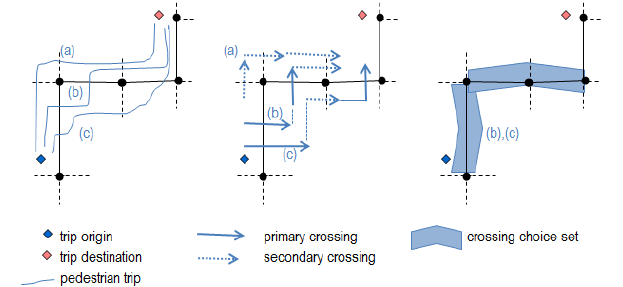
The objective of this research is the analysis of pedestrians risk exposure along urban trips in relation to pedestrians crossing behavior. First, an appropriate microscopic indicator is selected for the estimation of pedestrians risk exposure while road crossing at isolated locations. This indicator expresses exposure as the number of vehicles encountered by pedestrians during the crossing of a single uncontrolled road lane, and can be further adapted and applied for various road design and traffic control features. Moreover, the number and type of crossings along a pedestrian trip can be identified on the basis of the trip length and topology, whereas the choice set of alternative crossing locations for each crossing decision can also be defined. The crossing probability associated with each alternative location along the trip can be then estimated by means of a sequential logit model. Finally, a method is presented for the estimation of pedestrians exposure along a trip in relation to their crossing behavior. The proposed approach is demonstrated on the basis of a pilot implementation, for a typical pedestrian trip in the centre of Athens, Greece, for four scenarios combining different traffic conditions and pedestrians’ walking speed. The results show that pedestrians’ exposure along a trip is significantly affected by their crossing choices, as well as by road and traffic characteristics. It is also revealed that pedestrians with increased walking speed may partly compensate for their risk exposure, so that it is not significantly affected by traffic volume. Moreover, specific locations with increased pedestrian risk exposure can be identified for each trip. The proposed microscopic analysis of pedestrian exposure is proved to be advantageous compared to existing macroscopic ones, revealing the different possible definitions and aspects of pedestrians exposure, with useful implications for road safety analysis.
| ID | pc119 |
| Presentation | |
| Full Text | |
| Tags | accident analysis, pedestrians |













